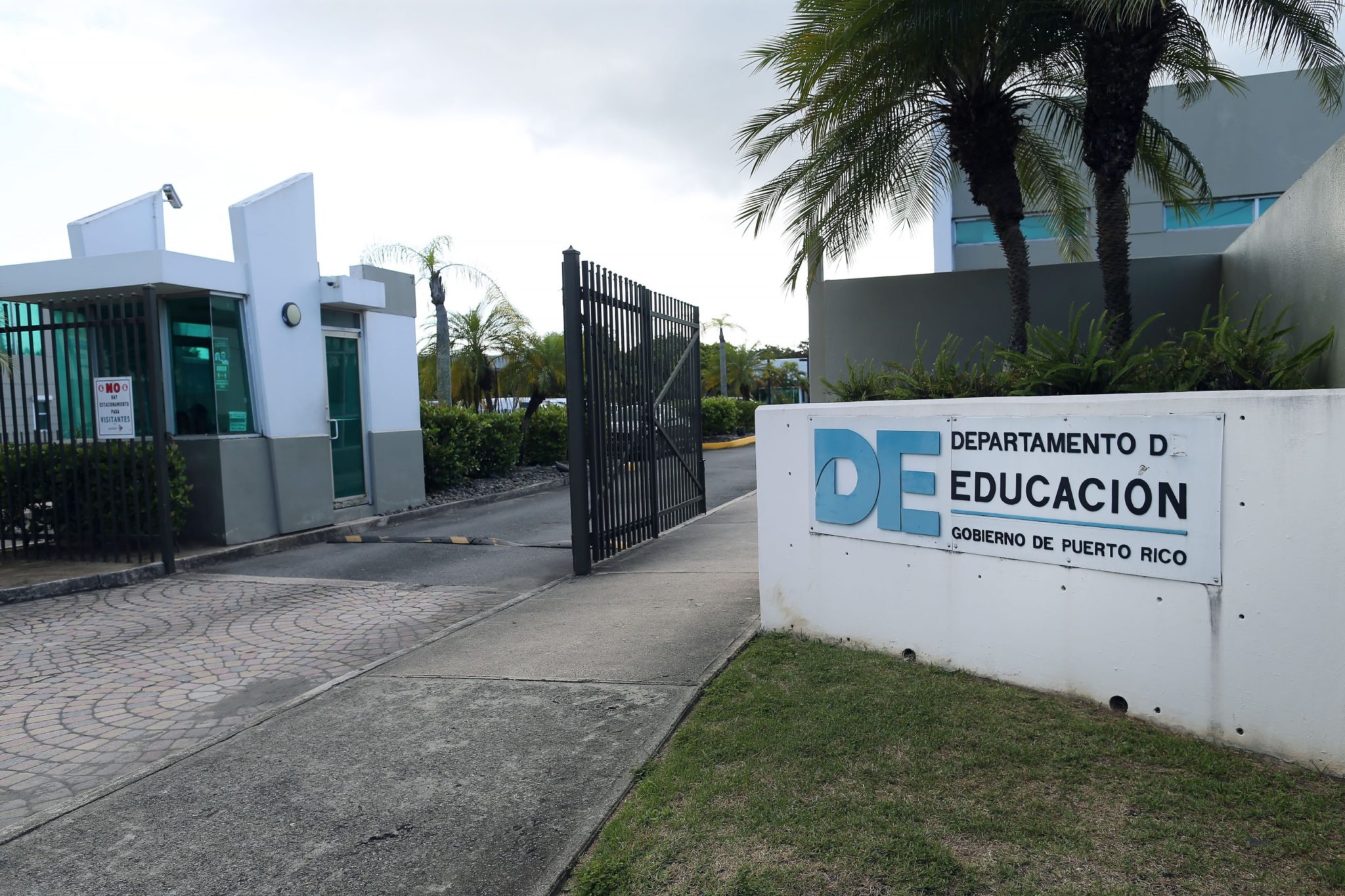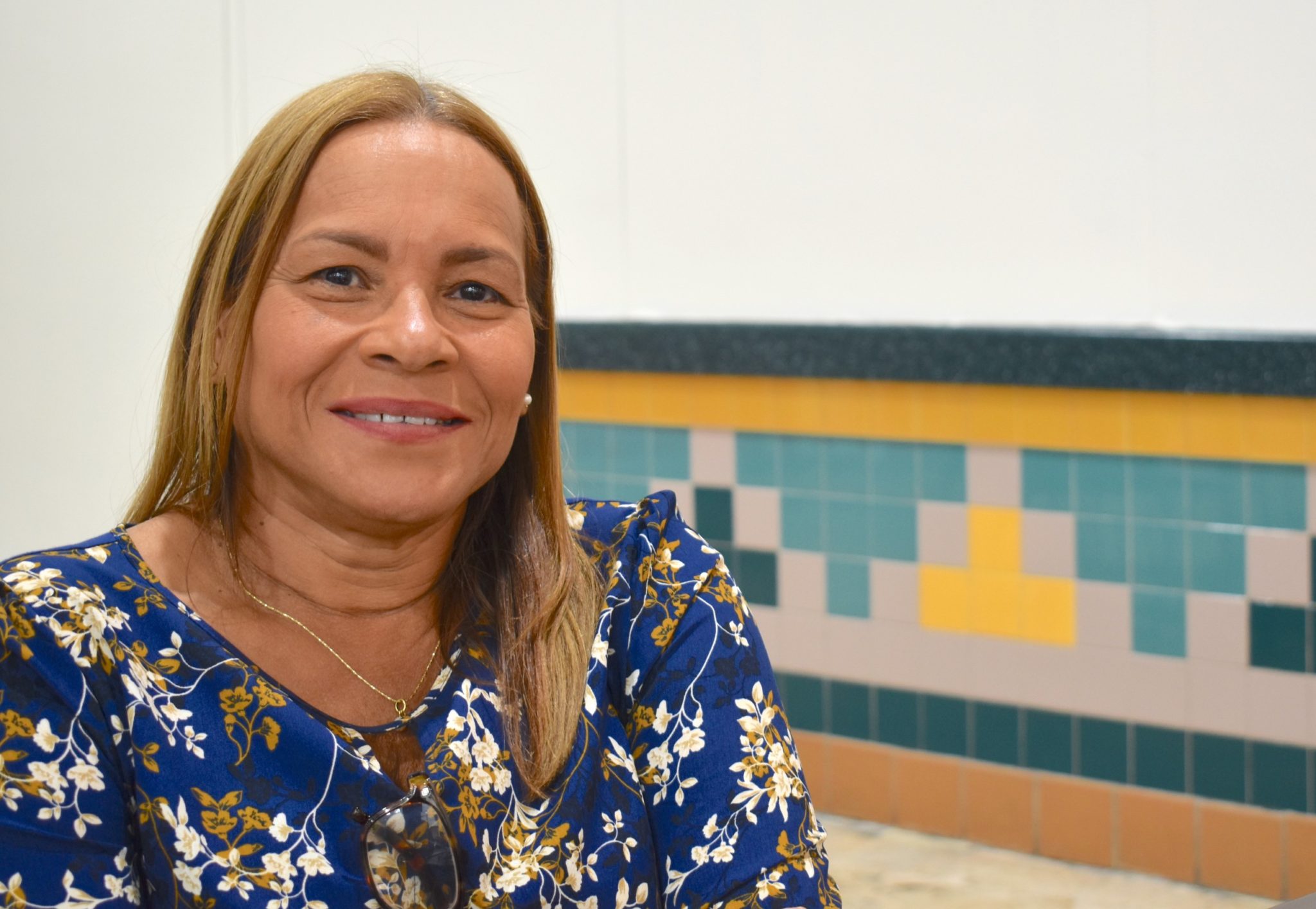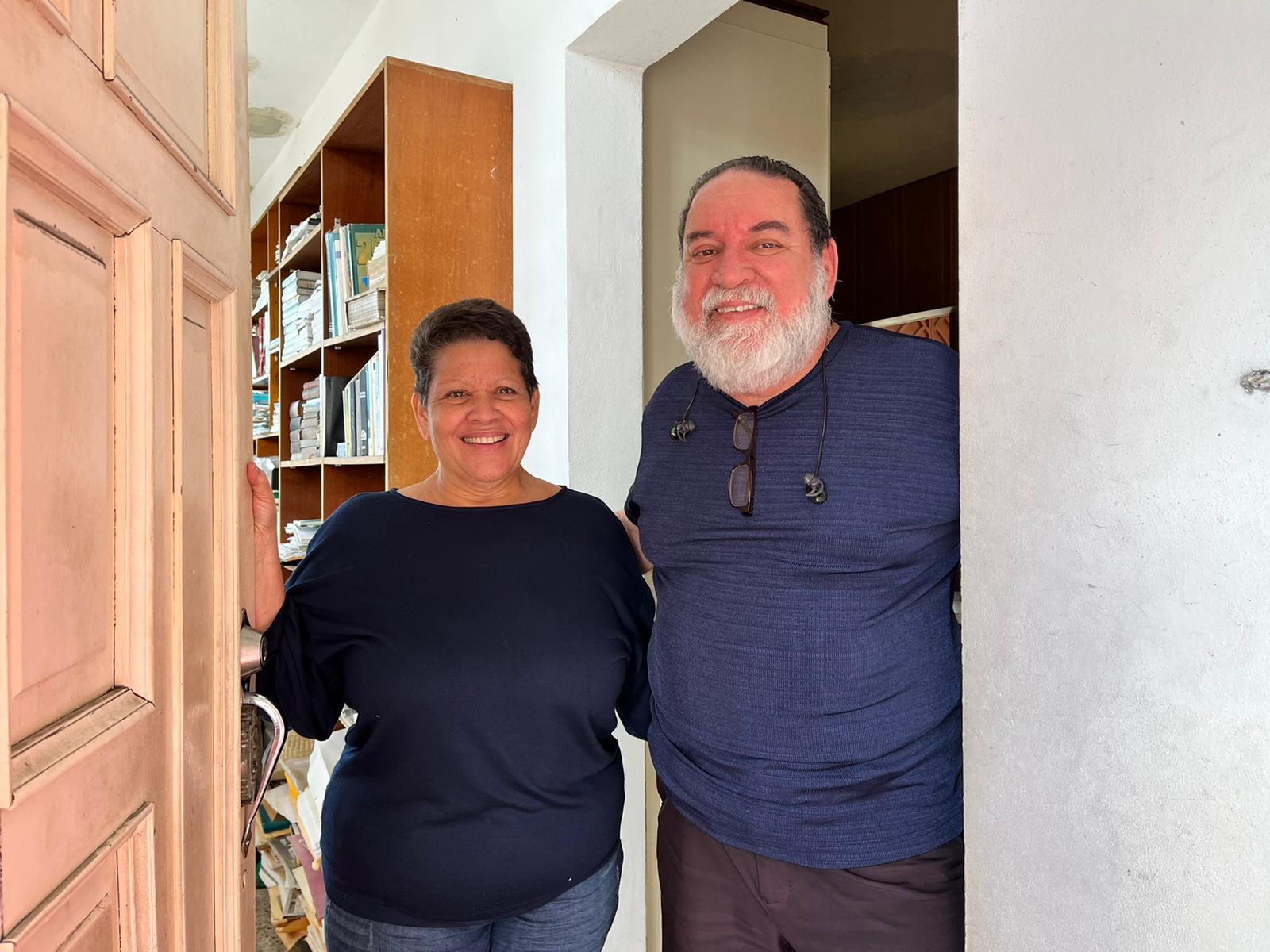

Courtesy of Centro de Periodismo Investigativo
By José Manuel Encarnación Martínez
SAN JUAN, Puerto Rico — The teacher prep period is up. The bell rings and the students start coming into the classroom. The 50 minutes of preparation were spent calling parents who had not followed up on their children’s performance in school and completing referrals to the social worker. Those 50 minutes are the time teachers have available each day, in theory, to organize their class material, upload information about their students to the Department of Education’s (DE) digital archives, or get other tasks done.
But the educator —who prefers not to identify herself— teaches five groups, at least 125 students in total. She takes home paperwork and material that remains to be uploaded today, two sets of homework papers (approximately 250 results), plus referrals to the social worker and one referral to the school psychologist. And this happens every week. It’s her routine.
“The teachers have always done everything, but this has gotten out of control now with the paperwork, the documents, and all the reports that they ask for,” she said. “I even duplicate work. As an example, I have to work on attendance twice, once by hand and again by entering it into the Student Information System (SIE) on the computer. It’s as if the less important thing is the class that I must teach.”
The SIE is the digital platform where the DE collects all the student information.
“Sometimes I have to dedicate Sundays or weekends to deal with all this because it’s impossible to balance everything in an hour,” she said. “I do it this way because I worry about having my classes ready and not teaching the same thing to all the groups. Each group goes at a different pace.”
The teacher is supposed to design a weekly plan online, a process that “isn’t limited to a digital document that is sent to the school director, but requires evaluating literature, assessment exercises (such as oral and written tests, research projects, oral presentations, reflective diaries), and other aspects.”
Suppose the teacher wants to incorporate a video in one of her classes. In that case, she needs to evaluate it to justify its appropriateness, prepare her class presentation, and develop a practice exercise or the evaluation document. If the activity required a student evaluation, she would also have to prepare it or select one that fits the skill. That process is multiplied by five groups for each day. If they were writing assignments, instructions would have to be detailed step-by-step.
“And on top of that, differentiated and coordinated instructions with the Special Education teacher,” she adds. For each of her five groups, she must adapt the material for the Special Education Program students, who represent more than 30 percent of the enrollment in the public education system.


The Department of Education held schools responsible for data collection, which placed an additional burden on teachers.
(José “Pipo” Reyes/Centro de Periodismo Investigativo)
The issue is not new. Teachers’ Association representatives have been claiming since at least 2016 that paperwork and bureaucracy have threatened the teacher’s vocation. That same year, the DE, under the administration of Rafael Román, published the Data Governance in the Department of Education report, which established that “proactive Data Governance can make decision-making more effective to implement strategies that increase the academic achievement of students and better educational offerings, tempered to the needs of current and future society.”
Following this administrative guideline, the school was identified as “responsible for the accuracy, quality, and integrity of these (student data), following the processes established by the institution. They must comply with the DE’s information requirements.” Expectations remained on paper, while the demand for data placed an additional burden on educators.
The teacher sits at her desk, where family photos are side by side with class paperwork and what she needs to fill out “to meet administrative requirements.” She writes in a notebook to not forget what she had left pending. She staples some loose sheets and remembers that she still had to correct all her students’ work.
“Not only that, assign scores because I have to get them to the student and the parent on time,” she explained. “In some schools, the calculation and analysis of results by groups are necessary to make adjustments in case re-teaching is needed or to change strategies to re-evaluate them.”
Most of the documents on the teacher’s desk and computers, such as circular letters and attendance sheets, are unrelated to the teaching-learning process. There is also the “Referral to the Socioemotional Interdisciplinary Team,” a three-page document that teachers use to refer students, whether for academics, attendance problems, high-risk behaviors, health conditions, the possibility of abuse, or any other situation that is identified in the classroom. That document is also a fundamental part of the “paperwork.”
Of all the documents, planning distances the teacher from the teaching-learning process the most. “It’s important to plan, although it takes a long time, three or four hours,” the teacher said. “But I’m talking about the burden of spelling out goals, rewriting expectations, integrating with history class, and so on. For the Department, it’s more important that you develop all of this —when it is already on the curricular map— than the teacher’s performance. Because you can plan excellently, but you fail in execution. And the Department must improve on that because they evaluate you on those papers, the plan, instead of seeing what happens in the classrooms.”
Every 10 weeks, until completing the 40 weeks of the school year, teachers must fill out an academic progress report on the SIE platform for each of their students, and then deliver it and discuss it individually with the student’s legal guardians. But not all of the legal guardians follow up with students, so referring to the social worker, counselor, school psychologist, or other support staff becomes a recurring exercise throughout the school year.
“And one has to laugh because what they talk about the most is precisely how bad things are with the academic achievement of students,” she said. This indication of low academic achievement has been recurrent in recent years, particularly for the META tests, which have not been given since 2019 due to the COVID-19 pandemic. The proficiency in Spanish, English, and mathematics that these standardized tests collect shows a drop in the annual results of each of these subjects from 2017 to 2019. At least 24,000 students did not pass a grade last year.
The teacher said the root of this problem is that the students have become a secondary interest in the school.
“Everything is based on compliance,” she explained. “For example, the teacher often focuses on delivering lesson plans and evaluations to meet grades to meet academic progress reports. But you are told that they are coming to monitor the school, (and) everything must be in order and we must comply with the documents and information. And many times, with everything you must do, and the referrals that also must be done, making time when there is none, the academic or emotional needs of the students are not addressed … In other words, they rob Peter to pay Paul. If they offer them therapy with the school psychologist, for example, they have to skip class.
“And we’re in that circle all year long.”
She admits, however, that she enjoys what she does. She says that when she enters the classroom, she is transformed, because “the kids have nothing to do with this.” She tries to give her best “to at least impact two or three lives, even if they don’t get the A or the points that the system wants,” and in the official statistics, “they aren’t an example of student success.”
What keeps her going is “knowing that in my classroom there are human beings who can be transformed through significant experiences” that go beyond getting a perfect score in a multiple-choice exam.
She takes the opportunity to stress that the figure of today’s teacher has a different meaning than the one she experienced when she studied in the public system.
“There used to be more freedom,” she said. “Every teacher had their style. Every teacher was a great teacher with their own strategies. Now they tell you how you must be the teacher they want you to be. You must abide by the system. The students are not benefiting from that. And the teachers aren’t benefiting either.”
An Increasingly Interrupted Education
María Andino did not want to retire last year when she had already taught for more than 30 years in public service. But being a teacher didn’t feel the same as when she started teaching in the mid-1980s, when the DE was the Department of Public Instruction.


María Andino, who taught Spanish, says that “the paperwork increased.”
(José Manuel Encarnación Martínez/Centro de Periodismo Investigativo)
She raises her voice and closes her eyes when she talks about it. Her gestures express mixed feelings. She misses the dynamics with her students, but at the same time, she feels freed from “brutal pressures” that in the last decade began to limit her freedom in the classroom. The first thing she talks about is “the paperwork,” which “began to be more and more” and that “became the priority.”
She remembers her first years as a teacher, when she taught at the José Calzada Ferrer School in Canóvanas.
“Look, when a director visited you,” she recalled, “they didn’t come with a punitive intention. They came intending to help you and point out certain skills that you needed and that they were willing to help you achieve them and give you tools so that you could get there. And they evaluated you, but there wasn’t the pressure of so much paperwork.
“The system asks you for so many papers nowadays that the evaluation is about the papers looking good instead of how your work is and your teaching performance, which, after all, is what is important, teaching.”
She insists that she did not abandon teaching over the paperwork. She complied with the paperwork, but she did it during overtime, at home, “because it’s almost impossible to teach and comply with the pile of paperwork that they ask for now.”
For Andino, who always taught Spanish, the fact that they ask for so many documents is contradictory.
“You have the Student Information System (SIE), where you enter attendance, grades, etc. That same SIE provides a distribution of grades,” he explained. “It gives you a lot of information that they keep asking you for on paper. There is a great investment made in technology. Why then do they ask for the same on paper?”
Andino has her own opinion when asked why work is being duplicated in such way.
“Some directors, if not the majority, don’t know how to run the SIE. In addition, they want to have papers to comply with the monitoring that the DE does on them. And they lose sight of going to a classroom, seeing the teacher’s execution and not asking for so many papers. That causes many temporary teachers to live under pressure because everything depends on how they are evaluated. This has created, for me, a huge gap in the teaching-learning process.”
The temporary teacher must compete for a position with no guarantee of permanency in the system. Currently, around 4,370 DE teachers are temporary, according to the list of active employees that the agency offered to the CPI in February. This represents 18 percent of the total active teachers (24,785). As part of the requirements to compete for a position, temporary staff must submit evidence of their evaluations, a professional development plan and proof of professional development hours.
“When I was a rookie, my first director made the following clear to me: ‘You come here to educate and prepare (children).’ And I took it upon myself to understand that educating and preparing people is working with human rights, with values, and with the process that I want to develop in the classroom, that this is what education should be. But that has changed quite a bit. And it’s a shame,” Andino said.
About 32 percent of the school directors said that full and clear information is rarely received before the implementation of changes in the schools, when they were surveyed as part of the “Implications of the structure of the public education system of Puerto Rico in its operation (2021)” study conducted by Dr. Yolanda Cordero Nieves for the Public Education Observatory. In that same consultation, 43 percent said that important information is rarely received with enough time to disseminate it among the members of their school community properly. Likewise, 20 percent said they are never consulted about changes that affect their schools before making a decision. Some 44 percent said their approaches are rarely considered when something is decided at a higher level.
Although Act 85-2018, in its Article 2.12, recognizes the educator’s teaching autonomy, the measure establishes that “the Secretary of Education, the regional superintendents, as well as the school directors and the school councils will validate that educator’s teaching autonomy. This includes the freedom to: make changes that they deem pertinent to adapt the courses to the socio-cultural and geographical profile of the students, with prior approval from superiors; adopt the educational methodology that, according to professional judgment, best stirs the interest and curiosity of the students in the subjects to be studied; give unique attention to students with disabilities, as well as, high achievers or students with special abilities; and organize groups of students to carry out studies or special projects related to the courses.”
Something that comes up from the Cordero Nieves report is that “the natural inclination of bureaucracies toward uniformity, when matched by a high degree of centralization of decision-making power, creates serious dislocations in operation.” It also states that uniform policies from the central level negatively impact the daily functioning of the classroom.
Another issue that goes hand in hand with decentralization is the urgent need to deregulate the Department of Education. The impossibility of knowing the content of a large number of regulations and circular letters makes them of very little use. An adequate number of regulations would make them easier to enforce and more valuable in guiding the conduct of the school community, the report adds.
Gloria Ramírez was a social studies teacher from the 1980s until three years ago, and she didn’t want to retire either. She is sitting in the living room of her mother’s house —who was also a teacher for three decades— and next to her is her husband, Edwin Feliciano, who was a math teacher and, at the time, coordinator of Curriculum Review in Río Grande.
They talk about how work was handled in a home of two teachers.


Gloria Ramírez, a former social studies teacher, and her husband Edwin Feliciano, an ex-math teacher and Curriculum Revision coordinator in Río Grande.
(José Manuel Encarnación Martínez/Centro de Periodismo Investigativo)
Doña Gloria says she took a lot of work home because she was an active teacher in her school community. “I was on the discipline committee, and I was the president of the School Council,” she said.
The School Council is a leadership group that comprises all school community representatives: teachers, principals, students, parents, neighbors, or other leaders. Gloria explains that belonging to that group at her school was a responsibility and, at the same time, an opportunity to contribute to the improvement of her workspace.
In Gloria’s case, tasks were duplicated.
“I also had to have everything on the web [on digital platforms, like the SIE], and on paper,” she recalled.
She said the paperwork was for the director’s evaluation. “It was double work. And all in all, visits for evaluations, after so much effort, don’t even take 10 minutes. It was to look at the papers and that’s it. And another thing: not all directors master the material in your area,” she said, referring to the fact that the director may be oblivious to the disciplines they evaluate.
“When the time came at the Department of Education when the facilitators went to the school to evaluate your work, one time they sent me a Spanish facilitator because there was no History one. Since she didn’t master my area, she didn’t help me improve my performance. She was supposed to correct me, she didn’t, and I was making mistakes in a planning report for a long time,” she recalled. “No one told me I was doing something wrong until I went to training and found out. Since that experience, I never wanted a facilitator who wasn’t familiar with my area.”
Edwin intervenes, saying things were handled differently before, but “politics and money changed the way things were done.”
“I spent seven years working as a mathematics coordinator. I took specialized courses on different subjects, with international resources and from top international universities, and then I had to go and train school directors, the superintendent, etc. I went to the schools; I went into the classrooms to observe the classes, even voluntarily. It was a genuine commitment. To that, we must add that I had to give workshops to teachers in person: on educational strategies, planning, writing objectives, how to learn the curriculum, how to align the standards and the texts that have all that type of thing. The goal was to achieve a well-integrated education,” he recalled.
Gloria asks her husband to talk about what happened to everything that he describes.
“There was a change of government,” Edwin responded with frustration, referring to the transition from the administration of Rafael Hernández Colón to that of Pedro Rosselló González. “Since the Educational Reform that was being implemented was being done by the previous government, when the change of command came, everything that had to do with my duties [and others] as Curriculum Revision coordinator was eliminated. The culture of private companies prevailed, for which I also worked. But that’s disgusting.”
Gloria studied to be a lawyer and dedicated herself to educating “out of vocation and love of the profession.”
“The system is sometimes the one that puts so many obstacles in our way… and the excess of work to comply with the paperwork, which has nothing to do with the teaching-learning process. If more were done to improve what happens in the classroom, instead of complying with so much bureaucracy, I believe that public education would be at a higher level,” Gloria said.
New Curriculum Review: What For?
A new curricular review is underway as part of the strategies that the DE has announced to improve the academic offer and turn around the challenges they face with student achievement. The last time the curricular contents were reviewed was in 2016. Guillermo López Díaz, deputy secretary of Academic and Programmatic Affairs, believes this review is important, “but that curriculum, as precious as the plan may be, if a change in how the strategies or the content is not implemented in the classroom, there will be no change in student academic achievement.”
López Díaz acknowledged a gap between the teaching-learning process and the curriculum. But when he offered an example to illustrate part of the problem of Puerto Rico’s educational culture that they seek to impact, he focused on the teacher’s interpretation of the curriculum and did not note any aspect of the many that condition the teacher’s execution in their classroom.
“If I see a curriculum revision process and it says that fractions have to be taught differently because the curriculum was revised, and I go to the classroom and teach fractions as we have always done, you aren’t going to find relevance in the process and the learning outcome will be the same,” he said.
The Deputy Secretary acknowledged that the DE does not have a study that details how the closure of hundreds of schools in Puerto Rico is reflected in the academic achievement of its students. When asked if the high ratio of students to teachers in the classroom was still a problem, even in the context of a historical reduction of schools, López Díaz evaded the question and said, “beyond the number of students by teacher, (the problem) is the type of strategy that is being used.” He insisted on presenting the teacher as the protagonist in the processes and recognized that it is urgent to look closely at the phenomenon of the federalization of the educational system and the accountability model.
And he refers to the following: “Since the No Child Left Behind Act, the system has been under a structure of what is known in many institutions as compliance. We must comply with sending data to the US Department of Education and that leads us to use data only to show what has happened,” López Díaz pointed out.
University of Puerto Rico Professor José Caraballo Cueto published a study in August 2020 on the impact of the elimination of schools on students’ academic achievement in the public system. Among the conclusions is that “it was found that the closure of schools negatively impacted the academic achievement of displaced students.”
“Two years after the closure, the impacted students still got significantly lower results than their counterparts not affected by the closures,” he recalled.
The Caraballo Cueto study brought to the table the element of low academic performance of those students and the fact that the closures don’t represent savings in the coffers of the agency with the largest budget in Puerto Rico.
At the end of the last school semester, the CPI reported that after a multi-million dollar investment in diagnostic tests, no complete and accessible information would allow directors and teachers to work in lag areas. The problem continues to this day.
There is a public policy for academic support and technical assistance to directors and teachers in the public system. DE states that these processes “are evidenced” through the Compliance and Monitoring Website, which oversees interventions and reports on the work carried out in schools. Within this “support” structure are the teaching facilitators, who must develop curricular materials, visit the teacher in an ongoing and sustained manner, follow up on the guidance offered, support the teacher in handling students with special needs, guide the teacher on how to provide education adjusted to the needs and learning styles of students, and collaborate in the preparation of teaching plans, activities and differentiated exercises. In addition to this extensive list of responsibilities, there is a regular meeting with school principals to discuss findings found during visits to teachers in the classroom, among other tasks.
The facilitators are legally recognized as teachers, and it is emphasized that they do not exercise administrative and managerial duties. “Their main duty is and will be to support teaching,” according to the explanatory statement of an amendment to the 2018 Educational Reform (Law 85), for “clearly and precisely establishing the rights, duties, and responsibilities of the teaching facilitators.”
“It’s essential that teaching facilitators enjoy the same fringe benefits and rights as classroom teachers, regardless of their location,” according to the measure authored by New Progressive Party (PNP, in Spanish) Sen. Thomas Rivera Schatz. The teacher who received us in her classroom does not remember the last support visit of a teaching facilitator specialized in her subject (Spanish).
As of February, there were only 125 active teaching facilitators in Puerto Rico and 19 had a termination date of June 30, 2022, according to a breakdown of employees that the CPI requested from the DE. The DE had at least 219 teaching facilitators in 2010, and after five years, the number jumped to 500. Today, teachers have fewer support staff, while their administrative responsibilities have increased through new technology platforms and documents handled as part of the accountability system imposed for educational reform.
José Manuel Encarnación Martínez is a member of Report for America.


